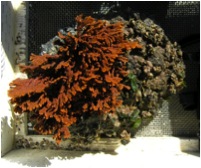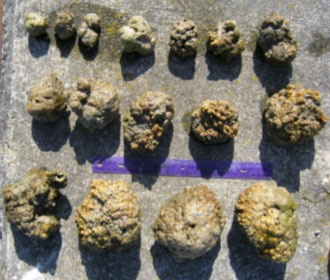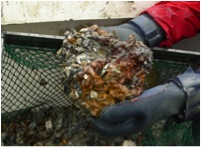by Monaca Noble
What are these rocks doing on the mudflat? That was the question a group of researchers in San Francisco’s South Bay asked in 2005. They were engaged in a native oyster restoration project when they stumbled upon some rather large rocks. They kicked one to the surface and recognized it as a bryozoan colony. SERC researcher Chela Zabin realized that this free-living bryozoan colony was very unusual; normally they grow on hard surfaces. Zabin and Joshua Mackie, of San Jose State University, identified the organism as Schizoporella errata, a type of calcified encrusting bryozoan that usually grows on pilings, boat hulls and docks.S. errata is native to the Mediterranean and was discovered in San Francisco Bay in 1979. Typically it looks like a hard crust and takes on the shape of its substrate. But now it was clear that S. errata had a new growth form that was not attached to anything. This rock-like form is called a “bryolith.” Although similar species are known to form bryoliths elsewhere, this was the first time one had been seen for S. errata or in San Francisco Bay. With this modification, S. errata was able to invade a whole new habitat that was previously unavailable.
Zabin works in SERC’s Marine Invasions lab and hypothesized that these bryolith balls would provide a unique habitat for other species. She wanted to investigate further. Zabin teamed up with colleagues Rena Obernolte and Marine Sciences Institute boat captain Jackson Gentry. The three wanted to find out where else in the Bay the bryoliths existed, how they form and what other species were associated with them. To their surprise, they discovered that these bryolith balls were very abundant in some locations. And some were large enough to be visible in the boat’s depth finder. Zabin’s team learned that S. errata had not only increased its range, but also the range of many other species. They found more than 50 species living on the S. errata bryolith balls and were able to identify 34 of these species and determine whether or not they were native to San Francisco Bay. Of the identified species, 74% were introduced. Many of these were species that only live on hard substrates, like the habitat S. errata created.
During the course of their investigations the team learned that this form of S. errata was actually found in San Francisco Bay some 30 years ago. However, Zabin and her partners were the first to examine and identify the mysterious orange “rocks.” They conducted the research in their spare time and bought supplies with their own funds. The team’s volunteer efforts paid off. They have published their findings in the journal Marine Ecology Progress Series. Two areas of future work include mapping the density of S. errata on the mudflats and identifying its impact on San Francisco Bay’s ecology.
This article is the Marine Invasions Lab’s feature story for February.
The full citation for Zabin’s paper is: Zabin CJ, R Obernolte, JA Mackie, J Gentry, L Harris, and J Geller. 2010. A non-native bryozoan creates novel substrate on the mudflats in San Francisco Bay. Mar. Ecol. Prog. Ser. 412:129-139




